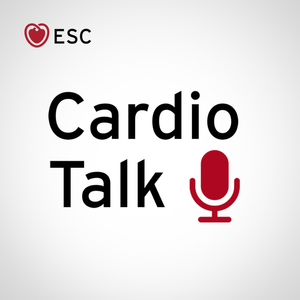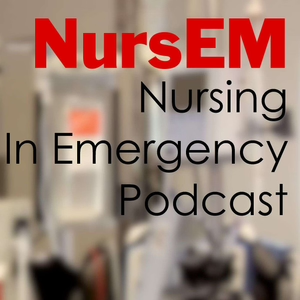
Circulation: Arrhythmia and Electrophysiology May 2020 Issue
12/16/20 • 17 min
Paul J. Wang:
Welcome to the monthly podcast, On the Beat for Circulation: Arrhythmia and Electrophysiology. I'm Dr. Paul Wang, Editor-in-Chief, with some of the key highlights from this month's issue. In our first paper, Bruce Wilkoff and associates examine the impact of cardiac implantable electronic device [CIED] infections on mortality, quality of life, healthcare utilization, and cost in the U.S. Healthcare system. They found that the majority CIED infection was associated with increased all-cause mortality, 12-month risk-adjusted hazard ratio 3.41, P < 0.001. An effect that sustained beyond 12 months.
The quality of life was reduced, P = 0.004, and did not normalize for six months. Disruptions in CIED therapy were observed in 36% of infections for a median duration of 184 days. The authors reported that the mean hospital costs were $55,547.
In our next paper, Songwen Chen, Xiaofeng Lu and associates examine the ability to eliminate premature ventricular complexes [PVCs] originating from the proximal left anterior fascicle, safely from the right coronary sinus. The authors mapped the the right coronary sinus and left ventricle in 20 patients with left anterior fascicle PVCs. They found that the earliest activation site with Purkinje potential during both PVC and sinus rhythm was localized at proximal left anterior fascicle in eight patients, the proximal group, or non-proximal left anterior fascicle in 12 groups, the non-proximal group. The Purkinje potentials proceeded PVC-QRS at the earliest activation site in proximal group 32.6 milliseconds was significantly earlier than that in non-proximal group, 28.3 milliseconds P = 0.025. Similar difference in the Purkinje potentials proceeding sinus QRS at the earliest activation site was also observed between proximal and non-proximal group, 35.1 milliseconds versus 25.2 milliseconds, P < 0.001.
In proximal group, the distance between the earliest activation site to the left His-bundle into the right coronary sinus were shorter than that of the non-proximal group 12.3 millimeters versus 19.7, P = 0.002, and 3.9 millimeters versus 15.7 millimeters, P < 0.001, respectively. The authors found no difference in the distance between the right coronary sinus to proximal left anterior fascicle between the two groups. PVCs were successfully eliminated from the right coronary sinus in all proximal group, but at left ventricular earliest activation site for the non-proximal group, the radiofrequency application time, ablation time and procedure time of non-proximal group were longer than that proximal group.
Electrocardiographic analysis showed that when compared to non-proximal group, the PVCs proximal group had a narrower QRS duration, smaller S wave in leads one, V five,and V six; lower R waves in leads one, aVL, aVR, V one, V two, and V four and smaller q wave in leads three and aVF. The QRS duration difference [PVC-QRS and sinus rhythm QRS] < 15 milliseconds predicted the proximal left anterior fascicle origin with high sensitivity and specificity.
In our next paper, Benjamin Steinberg and associates examined the factors that are associated with large improvements in health-related quality of life in patients with atrial fibrillation. The authors assessed factors associated with a one-year increase in quality of life, measured by AFEQT of one standard deviation that is greater and equal to 18 points, three times clinically important difference among patients in the ORBIT-AF one registry. They found that 28% of patients had such a health-related quality improvement compared with patients not showing large health-related quality of life improvement. They were similar age, (median 73 versus 74 years of age), equally likely to be female, (44% versus 48%), but more likely to have newly diagnosed atrial fibrillation [AF] at baseline (18% versus 8%, P = 0.0004) prior antiarrhythmic drug use (52% versus 40%, P = 0.005), baseline antiarrhythmic drug use (34.8% versus 26.8%, P = 0.045), and more likely to undergo AF related procedures during follow-up (AF ablation 6.6% versus 2.0%, cardioversion 12.2% versus 5.9%). In multivariate analysis, a history of alcohol abuse has a ratio 2.4 and increased baseline diastolic blood pressure has a ratio 1.23 per 10 point increase and greater than 65 millimeters of mercury were associated with large improvements in health-related quality of life at one year. Whereas patients with prior stroke, chronic obstructive pulmonary disease and peripheral artery disease were less likely to improve.
In our next paper, Eiichi Watanabe and associates studied safety and resource consumption of exclusive remote follow-up in pacemaker patients for two years. Consecutive pacemaker patients committed to remote pacemaker management were randomized to either remote follow-up or conventional in-office follow-up at twice yearly intervals.
Remote follow-up patients were only seen if i...
Paul J. Wang:
Welcome to the monthly podcast, On the Beat for Circulation: Arrhythmia and Electrophysiology. I'm Dr. Paul Wang, Editor-in-Chief, with some of the key highlights from this month's issue. In our first paper, Bruce Wilkoff and associates examine the impact of cardiac implantable electronic device [CIED] infections on mortality, quality of life, healthcare utilization, and cost in the U.S. Healthcare system. They found that the majority CIED infection was associated with increased all-cause mortality, 12-month risk-adjusted hazard ratio 3.41, P < 0.001. An effect that sustained beyond 12 months.
The quality of life was reduced, P = 0.004, and did not normalize for six months. Disruptions in CIED therapy were observed in 36% of infections for a median duration of 184 days. The authors reported that the mean hospital costs were $55,547.
In our next paper, Songwen Chen, Xiaofeng Lu and associates examine the ability to eliminate premature ventricular complexes [PVCs] originating from the proximal left anterior fascicle, safely from the right coronary sinus. The authors mapped the the right coronary sinus and left ventricle in 20 patients with left anterior fascicle PVCs. They found that the earliest activation site with Purkinje potential during both PVC and sinus rhythm was localized at proximal left anterior fascicle in eight patients, the proximal group, or non-proximal left anterior fascicle in 12 groups, the non-proximal group. The Purkinje potentials proceeded PVC-QRS at the earliest activation site in proximal group 32.6 milliseconds was significantly earlier than that in non-proximal group, 28.3 milliseconds P = 0.025. Similar difference in the Purkinje potentials proceeding sinus QRS at the earliest activation site was also observed between proximal and non-proximal group, 35.1 milliseconds versus 25.2 milliseconds, P < 0.001.
In proximal group, the distance between the earliest activation site to the left His-bundle into the right coronary sinus were shorter than that of the non-proximal group 12.3 millimeters versus 19.7, P = 0.002, and 3.9 millimeters versus 15.7 millimeters, P < 0.001, respectively. The authors found no difference in the distance between the right coronary sinus to proximal left anterior fascicle between the two groups. PVCs were successfully eliminated from the right coronary sinus in all proximal group, but at left ventricular earliest activation site for the non-proximal group, the radiofrequency application time, ablation time and procedure time of non-proximal group were longer than that proximal group.
Electrocardiographic analysis showed that when compared to non-proximal group, the PVCs proximal group had a narrower QRS duration, smaller S wave in leads one, V five,and V six; lower R waves in leads one, aVL, aVR, V one, V two, and V four and smaller q wave in leads three and aVF. The QRS duration difference [PVC-QRS and sinus rhythm QRS] < 15 milliseconds predicted the proximal left anterior fascicle origin with high sensitivity and specificity.
In our next paper, Benjamin Steinberg and associates examined the factors that are associated with large improvements in health-related quality of life in patients with atrial fibrillation. The authors assessed factors associated with a one-year increase in quality of life, measured by AFEQT of one standard deviation that is greater and equal to 18 points, three times clinically important difference among patients in the ORBIT-AF one registry. They found that 28% of patients had such a health-related quality improvement compared with patients not showing large health-related quality of life improvement. They were similar age, (median 73 versus 74 years of age), equally likely to be female, (44% versus 48%), but more likely to have newly diagnosed atrial fibrillation [AF] at baseline (18% versus 8%, P = 0.0004) prior antiarrhythmic drug use (52% versus 40%, P = 0.005), baseline antiarrhythmic drug use (34.8% versus 26.8%, P = 0.045), and more likely to undergo AF related procedures during follow-up (AF ablation 6.6% versus 2.0%, cardioversion 12.2% versus 5.9%). In multivariate analysis, a history of alcohol abuse has a ratio 2.4 and increased baseline diastolic blood pressure has a ratio 1.23 per 10 point increase and greater than 65 millimeters of mercury were associated with large improvements in health-related quality of life at one year. Whereas patients with prior stroke, chronic obstructive pulmonary disease and peripheral artery disease were less likely to improve.
In our next paper, Eiichi Watanabe and associates studied safety and resource consumption of exclusive remote follow-up in pacemaker patients for two years. Consecutive pacemaker patients committed to remote pacemaker management were randomized to either remote follow-up or conventional in-office follow-up at twice yearly intervals.
Remote follow-up patients were only seen if i...
Previous Episode

Circulation: Arrhythmia and Electrophysiology April 2020 Issue
Paul J. Wang:
Welcome to the monthly podcast On the Beat, for Circulation: Arrhythmia and Electrophysiology. I'm Dr. Paul Wang, Editor-in-Chief, with some of the key highlights from this month's issue.
In our first paper, David Okada and associates assess the ability of a novel machine learning approach for quantifying 3D spatial complexity of gray scale patterns on late gadolinium-enhanced cardiac magnetic resonance images to predict ventricular arrhythmias in patients with ischemic cardiomyopathy.
They examined 122 consecutive ischemic cardiomyopathy patients with left ventricular ejection fraction of 35%, without prior history of reentrant ventricular arrhythmias. These patients underwent late gadolinium-enhanced cardiac magnetic resonance imaging. From raw gray scale data, the authors generated graphs encoding the 3D geometry of the left ventricle. They then assess the global regularity of signal intensity patterns using Fourier-like analysis and generated a substrate spatial complexity profile for each patient. A machine learning statistical algorithm was employed to discern which substrate spatial complexity profiles correlated with ventricular arrhythmic events. That is appropriate ICD firings and arrhythmic sudden cardiac death.
At five years of follow-up from the statistical machine learning results, a complexity score ranging from zero to one was calculated for each patient that was tested using multivariate Cox regression models. At five years of follow-up, 40 patients had ventricular arrhythmia events. The machine learning algorithm classified with overall 81% accuracy and correctly classified 86% of those without ventricular arrhythmia. Overall negative predictive value was 91%. Average complexity score was significantly higher in patients with ventricular arrhythmia events versus those without P
Next Episode

Circulation: Arrhythmia and Electrophysiology June 2020 Issue
Paul J. Wang:
Welcome to the monthly podcast, On the Beat for Circulation: Arrhythmia and Electrophysiology. I'm Dr. Paul Wang, editor in chief, with some of the key highlights from this month's issue.
In our first paper, Vivek Reddy and associates studied a novel, 7.5, French lattice tip catheter with the compressible 9 mm nitinol tip that is able to deliver either focal radio frequency ablation [RFA] or pulsed field ablation [PFA], 2 to 5 second lesions. In a 3 center, single-arm, first in human trial, the catheter was used with a custom mapping system to treat paroxysmal or persistent atrial fibrillation. Toggling between energy sources, point by point, pulmonary vein [PV] encirclement was performed using biphasic pulsed field ablation, posteriorly, and either temperature controlled irrigated RFA or pulse field ablation, anteriorly (RF/PF or PF/PF) respectively. Linear lesions were created with either PFA or RFA. The 76 patient cohort included 55 paroxysmal and 21 persistent atrial fibrillation [AF] patients undergoing either RF/PF [pulse field ablation] 40 patients or PF/PF ablation in 36 patients, pulmonary vein isolation therapy duration was 22.6 minutes per patient with a mean of 50.1 RF/PF ablation lesions per patient. Linear lesions included 14 mitral, 34 left atrial roof and 44 cavo-tricuspid isthmus lines with therapy duration times of 5.1, 1.8 and 2.4 min/patient respectively. All lesion sets were acutely successful using 4.7 minutes of fluoroscopy. There were no device-related complications, including no strokes. Post-procedure esophagogastroduodenoscopy revealed minor mucosal thermal injury in two of the 36 RF/PF and zero of the 24 PF/PF patients. Post-procedure brain MRI revealed DWI positive flair, negative and DWI positive flare positive asymptomatic lesions in 5 and 3 of the 51 patients respectively.
In our next paper, Moussa Saleh and associates examined whether chloroquine, hydroxychloroquine plus or minus azithromycin lead to a prolongation of the QT interval, possibly increasing the risk of torsades de pointes and sudden death in a hospitalized population of patients with COVID-19. 201 patients were treated for COVID-19 with chloroquine/hydroxychloroquine. 10 patients or 5% received chloroquine, and 191 or 95% received hydroxychloroquine and 119 or 59% also received azithromycin. The primary outcome of Torsades de pointes was not observed in the entire population. Baseline QTC interval did not differ between patients treated with chloroquine or hydroxychloroquine monotherapy versus those treated with combination group chloroquine/hydroxychloroquine and azithromycin (440 ms versus 439.9 ms). The maximum QT during treatment was significantly longer in the combination versus the monotherapy group, 470 ms versus 453 ms (P = 0.004). Seven patients (3.5%) required discontinuation of these medications due to QTC prolongation. No arrhythmic deaths were reported.
In our next paper, Mikko Tulppo and associates examine whether the association between leisure time physical activity and the risk of sudden death and non-sudden cardiac death in coronary artery disease patients. 1,946 patients with angiographically verified coronary artery disease were classified into four groups: inactive, irregularly active, active exercise regularly two to three times per week, and highly active, exercise four times or more weekly. During follow-up, median 6.3 years, 52 sudden cardiac death and 49 non-sudden cardiac deaths occurred. Inactive patients had increased risk for sudden cardiac death compared to active patients, hazard ratio 2.45. Leisure time was not associated with sudden cardiac death in patients with Canadian cardiovascular class one, 18 events in 1,107 patients. Among patients with Canadian cardiovascular society, class two or higher, 34 events in 839 patients. An increased risk for sudden cardiac death encountered in highly active patients, hazard ratio 7.46 (P < 0.001). In inactive patients hazard ratio 3.64 as compared to active patients. A linear association was observed between leisure time, physical activity and non-sudden cardiac death. Those with high leisure time physical activity had the lowest risk for non sudden cardiac death.
In our next paper, Jacob Koruth and associates examined the preclinical feasibility and safety of a 9mm lattice tip catheter with focal biphasic pulse field [PF] based thoracic vein isolation and linear ablation combined focal biphasic pulse field and radio-frequency [RF] focal ablation and vocal biphasic pulse field delivered directly on top of the esophagus. They treated two cohorts of six swine with pulse fields at low dose and high dose followed for four weeks and two weeks, respectively to isolate 25 thoracic veins and to create five right atrial low dose PF, six mitral high dose PF, and six roof lines with combined RF and high dose PF. Baseline and follow-up voltage mapping, venus potentials, ostial diameters and p...
If you like this episode you’ll love
Episode Comments
Generate a badge
Get a badge for your website that links back to this episode
<a href="https://goodpods.com/podcasts/circulation-arrhythmia-and-electrophysiology-on-the-beat-94401/circulation-arrhythmia-and-electrophysiology-may-2020-issue-10208833"> <img src="https://storage.googleapis.com/goodpods-images-bucket/badges/generic-badge-1.svg" alt="listen to circulation: arrhythmia and electrophysiology may 2020 issue on goodpods" style="width: 225px" /> </a>
Copy




